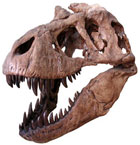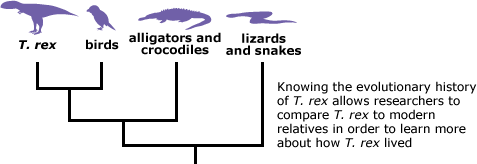
A six-ton carnivore with teeth the size of bananas is bound to make the news — even if that animal has been extinct for 65 million years. The recent spate of T. rex discoveries that have made headlines confirms this species’ star status. In June 2006, T. rex was reported to have had much better vision than previously thought — perhaps 13 times sharper than human vision! In July, a team of researchers estimated that T. rex had an average body temperature just 7 or 8°F lower than our own mammalian temperature. And most recently, biologists published work suggesting that, though relatively secure as youngsters, tyrannosaurs faced new dangers as they reached sexual maturity — causing their teen death rate to soar!
Where's the evolution?
Clearly, we can learn a lot about how the morphology, or body structure, of an organism has evolved by studying its fossils. But how do paleontologists go beyond morphology to reconstruct how an extinct animal moved, behaved, or made its living? These characteristics are incredibly important in our picture of the history of life on Earth, but they are not embedded directly in the fossil record. So how do biologists figure this stuff out? Recent T. rex discoveries exemplify just a few of the indirect methods that scientists use to learn about past life on Earth and how that life has changed over time.
To learn more about T. rex‘s vision, Kent Stevens at the University of Oregon built an eight inch long scale model of the animal’s head in order to figure out how much of its field of view both eyes can see at the same time, and hence, the quality of its depth perception. He also studied the vision of a few of T. rex‘s modern relatives — the alligator, ostrich, and eagle (see diagram) — and used scaled-up versions of these animals’ eyes to estimate T. rex‘s ability to see fine detail. These animals are closely related to T. rex but have eyes with different abilities — alligators have eyes adapted for night vision, the eagle has eyes adapted for extreme daytime acuity, and the ostrich has eyes with some night vision and some daytime acuity. By modeling T. rex‘s eyes on a set of eyes with the same basic layout as T. rex‘s, but adapted for slightly different situations, Kent figured out the range of visual abilities that T. rex might have possessed. The upshot of all of this is that T. rex probably had better depth perception than modern hawks and certainly had better visual acuity than humans do. These details of T. rex‘s vision have important implications for other hypotheses about how this dinosaur lived. From studying modern organisms, we know that active predators have generally evolved better vision than scavengers have. The fact that T. rex had such good vision factors into the discussion of whether it made its living as a predator, as a scavenger, or was simply opportunistic.
To learn more about extinct dinosaurs’ body temperatures, James Gillooly at the University of Florida and colleagues first collected information about the animals’ growth rate and mass, which is recorded in the microscopic structure of fossilized bone. After gathering this raw data, the team developed a mathematical model that relates growth rate and body mass to body temperature. To test the model, they turned to modern crocodiles — close relatives of dinosaurs, who probably inherited a similar metabolism from the ancestor that they share with dinosaurs. The researchers collected information on crocodile growth rate, body mass, and body temperature — and found that their mathematical model was quite good at predicting the body temperatures of crocodiles based on their growth rates and body masses. Next they applied the same model to dinosaurs; they used data on dinosaur growth rate and body mass to estimate the body temperatures of these long-dead animals. Their results suggest that T. rex and other large dinosaurs were somewhere between ectothermic and endothermic, not producing much heat of their own, but maintaining a relatively high and constant body temperature by virtue of their large size.
To learn more about how tyrannosaurs lived and died, Gregory Erickson from Florida State University and colleagues studied annual growth lines (which are a bit like tree rings) preserved in fossils of dinosaur leg and foot bones. But first they studied how growth lines are related to age at death in modern dinosaur relatives — crocodiles and lizards. As hoped, growth lines were a good method of predicting the age at which the animal died. The team then used fossilized growth lines, along with the lengths of the tyrannosaur bones, to estimate how old the dinosaurs were when they died so many millions of years ago. Tyrannosaurs, it seems, faced high mortality just after birth, but enjoyed high survival rates as juveniles. However, things turned dicey as the animals entered their teen years, when mortality rates spiked. Why? Perhaps, the researchers hypothesize, sexual maturity brings with it extra risks (e.g., fighting over mates) and demands (e.g., laying eggs) that made the life of a teen tyrannosaur more hazardous.
Investigating such details of past life requires evidence from unlikely sources. Paleontologists carefully analyze the shape of fossils left behind, of course, but they also rely upon microscopic studies of those fossils, mathematical models, physical models, and many other sources of data to evaluate their hypotheses. One of the keys to understanding what life was like far back in Earth’s history is a deep understanding of present life on earth. Because common ancestry links modern organisms, like crocodiles and birds, to long extinct organisms, like non-avian dinosaurs, studies of these modern organisms allow paleontologists to better evaluate the plausibility of their models and hypotheses.
Primary literature:
- Erickson, G. M., Currie, P. J., Inouye, B. D., Winn, A. A. (2006). Tyrannosaur life tables: An example of nonavian dinosaur population biology. Science 313:213-217. Read it »
- Gillooly, J. F., Allen, A. P., and Charnov, E. L. (2006). Dinosaur fossils predict body temperatures. PLoS Biology 4:e248. Read it »
- Stevens, K. A. (2006). Binocular vision in theropod dinosaurs. Journal of Vertebrate Paleontology 26(2):321-330. Read it »
News articles:
- A kid-friendly article on T. rex's vision from Science News
- A summary of the recent research on tyrannosaur life history patterns from MSNBC
- The Field Museum's website detailing how paleontologists have studied Sue, their massive T. rex
Understanding Evolution resources:
- A tutorial on evidence relevant to evolution, including fossil evidence
- A short essay on the contributions of Nicholas Steno, who first put forth the idea that fossils were the remains of past life on Earth
- A tutorial on evolutionary relationships — who is related to whom, how scientists figure this stuff out, and what we can learn from evolutionary trees
- What is morphology?
- By studying fossils, paleontologists can learn about more than just the morphology of long extinct organisms. List three topics, other than morphology, about which paleontologists can learn from studying fossils.
- Research a case in which paleontologists have gone “beyond the morphology” in studying the fossils of an organism other than T. rex. Briefly describe what the researchers found and what evidence supported their conclusions.
- Why did paleontologists also study modern birds and crocodiles when trying to learn more about T. rex?
- Read “What has the head of a crocodile and the gills of a fish?” which describes the recent discovery of fossils of Tiktaalik. What did scientists learn about Tiktaalik, besides just the shape of its body? To what organisms was Tiktaalik most closely related?
- Teach about interpreting the fossil record: In this web-based module for grades 9-12, students examine evidence from the fossil record, behavior, biomechanics, and cladistic analysis to interpret the sequence of events that led to flight in the dinosaur lineage.
- Teach about evolutionary relationships: In this web-based module for grades 6-12, students learn about evolutionary relationships and how these relationships can help them learn more about T. rex.
- Erickson, G. M., Currie, P. J., Inouye, B. D., Winn, A. A. (2006). Tyrannosaur life tables: An example of nonavian dinosaur population biology. Science 313:213-217.
- Gillooly, J. F., Allen, A. P., and Charnov, E. L. (2006). Dinosaur fossils predict body temperatures. PLoS Biology 4:e248.
- Stevens, K. A. (2006). Binocular vision in theropod dinosaurs. Journal of Vertebrate Paleontology 26(2):321-330.

